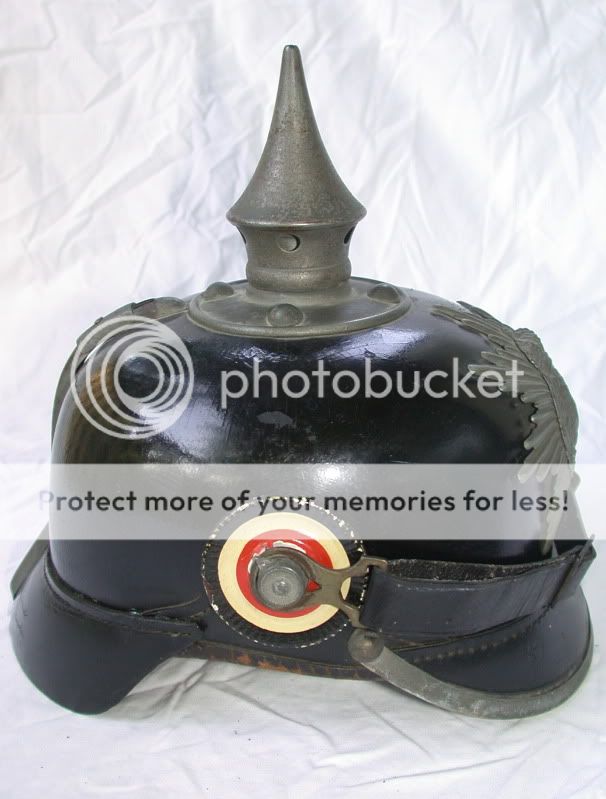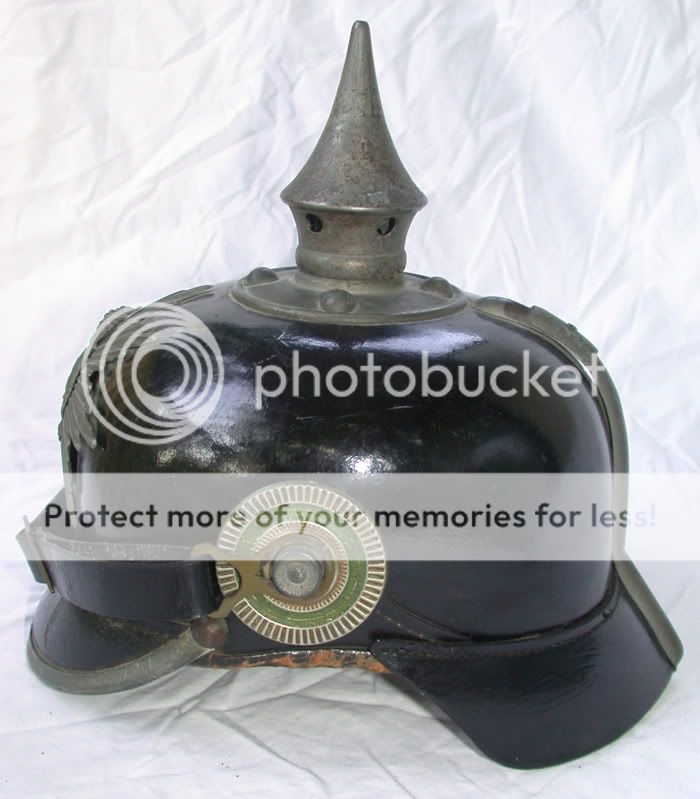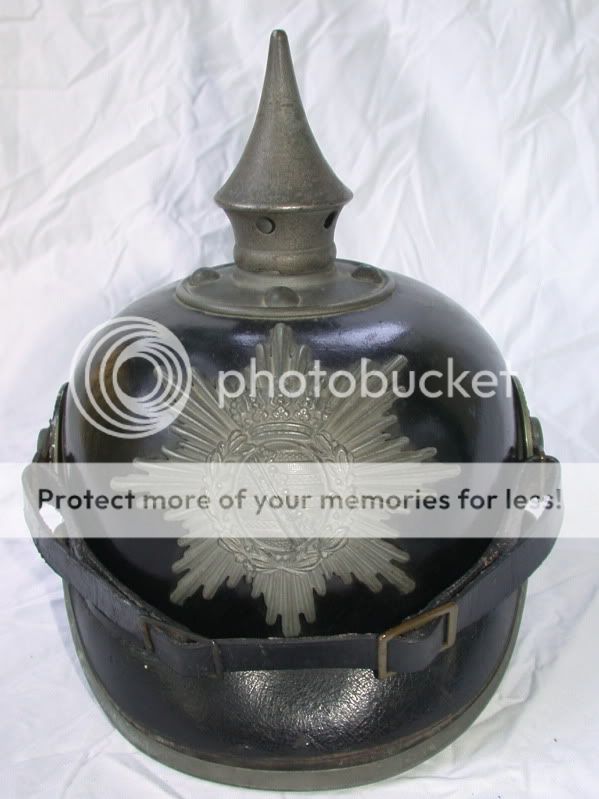You are using an out of date browser. It may not display this or other websites correctly.
You should upgrade or use an alternative browser.
You should upgrade or use an alternative browser.
The Saxon cockade
- Thread starter joerookery
- Start date
argonne
Well-known member
Joe,
You are right, much curious things observed with Hamburg hanseatic cockades...
My helmet comes straight from the family of the french militarian medic who brought it back after the battle of the Oise, September 1914. Never has been in a collection before. Helmet is marked R76 and RJR76 II B.
Helmet had only the hanseatic cokade on the left, nothing on the right even no traces of wear.
It´s well known that hanseatic people always were very proud about their "free city" and not liked very much the hegemonian prussian system. I think the Reich cokade has been removed by the soldier himself...
Philippe





You are right, much curious things observed with Hamburg hanseatic cockades...
My helmet comes straight from the family of the french militarian medic who brought it back after the battle of the Oise, September 1914. Never has been in a collection before. Helmet is marked R76 and RJR76 II B.
Helmet had only the hanseatic cokade on the left, nothing on the right even no traces of wear.
It´s well known that hanseatic people always were very proud about their "free city" and not liked very much the hegemonian prussian system. I think the Reich cokade has been removed by the soldier himself...
Philippe





Khukri
Well-known member
A translation of J-L Larcade Volume I chapter on the Kokarden: "In general"
Francis
Chapter 5:
Generalities about the Kokarden/Cocades:
Reglementations on the wearing of the Kokarden/Cocades: until 1897 this proved to be a highly complex matter, especially regarding the small States within the Army of the Norddeutscher Bund; the later Kaiserreich (Reich).
In order to avoid multiple and unnecessary repetitions, it seems a good idea to have a small chapter on the distinctive colors of these attributes and how they had to be worn. We describe the different colors of this Kokarden gradually from the outside inwards.
The THREE types of Kokarden are:
*the "Land kokarde"-"Country Cocade": in the colours of the “Land”-“Country”. On the Tschako's these colours are found on the "Feldzeichen"( or “National”)
* the "Deutsche Kokarde": the “German Cocade” during the Revolutionary Period (21 March 1848 until 14 March 1851). YELLOW-RED-BLACK. Worn on the left side of the helmet.
* the "Reichs Kokarde": the “Imperial Cocade” BLACK-WHITE-RED. Worn on the right side of the helmet from 22 March 1897 on.
On all Offz Kokarden: SILVER replaces WHITE and GOLD replaces YELLOW.
1867:
The colours of the Land Kokarde of the States are the following:
-Preussen: BLACK-WHITE-BLACK
-Bayern: WHITE-LIGHT BLUE-WHITE
-Saxony: WHITE-GREEN-WHITE
-Württemberg: BLACK-RED-BLACK
-Baden: YELLOW-RED-YELLOW
-Hessen-Darmstadt: WHITE-RED-WHITE-RED-WHITE
-Mecklemburg-Schwerin and Strelitz: BLUE-YELLOW-RED
-Oldenburg: BLUE-RED-BLUE
-Sachsen/Saxony-Weimar: YELLOW-GREEN-BLACK
-Braunschweig: BLUE-YELLOW-BLUE
-Anhalt: GREEN
-The three Herzogtümer (Duchies) of Sachsen (Saxony): GREEN-WHITE-GREEN
-Schwarzburg-Rudolstadt: DARK BLUE-WHITE-DARK BLUE
-Schwarzburg-Sonderhausen: WHITE-DARK BLUE-WHITE
-Reuss: YELLOW-RED-BLACK
-Schaumburg-Lippe: WHITE-RED-BLUE
-Lippe-kokarde Detmoldt: RED with a yellow outer ring
-Waldeck: YELLOW-RED-BLACK
-Hamburg; Bremen; Lübeck: WHITE with a RED-eightpointed-Maltese cross
1897:
Three Land Kokarden are to change:
-Sachsen-Weimar: from then on, GREEN-YELLOW-BLACK
-Bremen: WHITE-RED-WHITE: from then on, WITHOUT CROSS
-Hamburg: the simplified Maltese Cross (no longer eightpointed!): shaped as the Prussian Iron Cross.
In general: until 1897 a single Kokarde was worn on the right side; at the fixationpoint of the chinstraphalf. Or: on the front of the Tschako “the Feldzeichen”. Until 1897: the main Confederate States only wore their Land Kokarde.
This was not the case for certain small states that were annexed by Prussia. In addition to their own Land Kokarde they wore the Prussian Land Kokarde. Until 1897-a whole series of quirks existed:
-Oldenburg: The Offz only wore Pr Kokarde on the right side. The Mannsch wore the Kokarde of Oldenburg on the left hand side and the Prussian one on the right side.
-Anhalt; Saxony-Weimar; the three Duchies of Saxony; Reuss and Schwarzburg:
* Offz: Pr Kokarde: right side-Land Kokarde: left side.
* Mannsch: only the Land Kokarde: right hand side.
In general: each soldier serving in a unit-strange- to his homeland-wore TWO Kokarden: right side: the one of the unit in which he served. Left side: the one of his homeland!
This system resulted in an infinite variety of combinations concerning the wearing of Kokarden …
On the Tschako's; the Pelzmützen and Ulanen Tschapki the Feldzeichen had the colours of the "Land" to which the unit belonged. The Kokarde-in the colours of the wearers homeland- was worn at the right.
Another oddity with Braunschweig:
-up to 1866 the troops of this State wore their own Land Kokarde (Tschako: the Feldzeichen from 1872 on).
-From 1886 on: on the Pickelhaube: Pr Kokarde: right side; Kokarde of the soldiers “country of origin”: on the left.
22 March 1897: from this date on all these particularities disappeared: with the introduction of the Reichs-kokarde: for the entire German army. This Reichs Kokarde had to be worn at the right side, on the sidepost of the chinstrap half. The UNITS Land Kokarde was worn at the left side; NO LONGER the one of the soldiers country of orgin !
Francis
Chapter 5:
Generalities about the Kokarden/Cocades:
Reglementations on the wearing of the Kokarden/Cocades: until 1897 this proved to be a highly complex matter, especially regarding the small States within the Army of the Norddeutscher Bund; the later Kaiserreich (Reich).
In order to avoid multiple and unnecessary repetitions, it seems a good idea to have a small chapter on the distinctive colors of these attributes and how they had to be worn. We describe the different colors of this Kokarden gradually from the outside inwards.
The THREE types of Kokarden are:
*the "Land kokarde"-"Country Cocade": in the colours of the “Land”-“Country”. On the Tschako's these colours are found on the "Feldzeichen"( or “National”)
* the "Deutsche Kokarde": the “German Cocade” during the Revolutionary Period (21 March 1848 until 14 March 1851). YELLOW-RED-BLACK. Worn on the left side of the helmet.
* the "Reichs Kokarde": the “Imperial Cocade” BLACK-WHITE-RED. Worn on the right side of the helmet from 22 March 1897 on.
On all Offz Kokarden: SILVER replaces WHITE and GOLD replaces YELLOW.
1867:
The colours of the Land Kokarde of the States are the following:
-Preussen: BLACK-WHITE-BLACK
-Bayern: WHITE-LIGHT BLUE-WHITE
-Saxony: WHITE-GREEN-WHITE
-Württemberg: BLACK-RED-BLACK
-Baden: YELLOW-RED-YELLOW
-Hessen-Darmstadt: WHITE-RED-WHITE-RED-WHITE
-Mecklemburg-Schwerin and Strelitz: BLUE-YELLOW-RED
-Oldenburg: BLUE-RED-BLUE
-Sachsen/Saxony-Weimar: YELLOW-GREEN-BLACK
-Braunschweig: BLUE-YELLOW-BLUE
-Anhalt: GREEN
-The three Herzogtümer (Duchies) of Sachsen (Saxony): GREEN-WHITE-GREEN
-Schwarzburg-Rudolstadt: DARK BLUE-WHITE-DARK BLUE
-Schwarzburg-Sonderhausen: WHITE-DARK BLUE-WHITE
-Reuss: YELLOW-RED-BLACK
-Schaumburg-Lippe: WHITE-RED-BLUE
-Lippe-kokarde Detmoldt: RED with a yellow outer ring
-Waldeck: YELLOW-RED-BLACK
-Hamburg; Bremen; Lübeck: WHITE with a RED-eightpointed-Maltese cross
1897:
Three Land Kokarden are to change:
-Sachsen-Weimar: from then on, GREEN-YELLOW-BLACK
-Bremen: WHITE-RED-WHITE: from then on, WITHOUT CROSS
-Hamburg: the simplified Maltese Cross (no longer eightpointed!): shaped as the Prussian Iron Cross.
In general: until 1897 a single Kokarde was worn on the right side; at the fixationpoint of the chinstraphalf. Or: on the front of the Tschako “the Feldzeichen”. Until 1897: the main Confederate States only wore their Land Kokarde.
This was not the case for certain small states that were annexed by Prussia. In addition to their own Land Kokarde they wore the Prussian Land Kokarde. Until 1897-a whole series of quirks existed:
-Oldenburg: The Offz only wore Pr Kokarde on the right side. The Mannsch wore the Kokarde of Oldenburg on the left hand side and the Prussian one on the right side.
-Anhalt; Saxony-Weimar; the three Duchies of Saxony; Reuss and Schwarzburg:
* Offz: Pr Kokarde: right side-Land Kokarde: left side.
* Mannsch: only the Land Kokarde: right hand side.
In general: each soldier serving in a unit-strange- to his homeland-wore TWO Kokarden: right side: the one of the unit in which he served. Left side: the one of his homeland!
This system resulted in an infinite variety of combinations concerning the wearing of Kokarden …
On the Tschako's; the Pelzmützen and Ulanen Tschapki the Feldzeichen had the colours of the "Land" to which the unit belonged. The Kokarde-in the colours of the wearers homeland- was worn at the right.
Another oddity with Braunschweig:
-up to 1866 the troops of this State wore their own Land Kokarde (Tschako: the Feldzeichen from 1872 on).
-From 1886 on: on the Pickelhaube: Pr Kokarde: right side; Kokarde of the soldiers “country of origin”: on the left.
22 March 1897: from this date on all these particularities disappeared: with the introduction of the Reichs-kokarde: for the entire German army. This Reichs Kokarde had to be worn at the right side, on the sidepost of the chinstrap half. The UNITS Land Kokarde was worn at the left side; NO LONGER the one of the soldiers country of orgin !
poniatowski
Well-known member
Great thread folks!
Having seen all sorts of uniform mix-ups during service, it's easy to imagine a soldier placing the cockades on the wrong side after cleaning the helmet or otherwise removing the chin strap. Unfortunately, he didn't have somebody inspect him before his photo!
 Ron
Ron
Having seen all sorts of uniform mix-ups during service, it's easy to imagine a soldier placing the cockades on the wrong side after cleaning the helmet or otherwise removing the chin strap. Unfortunately, he didn't have somebody inspect him before his photo!
joerookery
Well-known member
I thought I would just point out if you missed it that Philippe has an extremely rare Landwehr cross on his helmet. You don't see a lot of these. :salute:
argonne
Well-known member
SkipperJohn
Well-known member
I have read this thread several times, both before and after I joined the forum, and I have gotten quite an education. I still; however, haven't come up with an answer to my dilemma. About ten years ago I bought a private purchase Saxon Pioneer helmet. It only had one Kokarde, the Saxon one, and it was an officer type. Initially I thought it might be a Fahnrich, but then decided that it must be enlisted with an incorrect Kokarde. The Kokarde has put a ghost on the helmet shell so it has been there for a while. This Kokarde is different than any pictured above because it is manufactured to fit an M91 lug.



I looked for a national Kokarde to match, but never found one. I then wondered if a Fahnrich would use this type of chinscale rather than a rosette. The Kokarde only fits the outer part of the M91 post and does not go over the step. Also the Kokarde shows no signs of being machined or altered from it's original state.


Assuming that this is an enlisted helmet, and I need enlisted Kokarden to complete it, I began the search. Now I am wondering what type I need, serrated, non-serrated, lime green, forest green, large, small --- I'm so confused.
Ultimately I left the helmet alone.

 [/URL]
[/URL]
I am open to opinions and suggestions on how to make this right.
John :-?



I looked for a national Kokarde to match, but never found one. I then wondered if a Fahnrich would use this type of chinscale rather than a rosette. The Kokarde only fits the outer part of the M91 post and does not go over the step. Also the Kokarde shows no signs of being machined or altered from it's original state.


Assuming that this is an enlisted helmet, and I need enlisted Kokarden to complete it, I began the search. Now I am wondering what type I need, serrated, non-serrated, lime green, forest green, large, small --- I'm so confused.
Ultimately I left the helmet alone.



I am open to opinions and suggestions on how to make this right.
John :-?
poniatowski
Well-known member
SkipperJohn
Well-known member
poniatowski said:I might as well put this one on here. This is a Saxon Unteroffizier Schule M15.
Ron
And the confusion goes on --- and on --- and on???
John :?
SkipperJohn
Well-known member
b.loree said:There are many things in the "world of Haube" that can not be explained John. A couple of pics of Saxe officer kokarden taken from my recent artillery officer restoration:
No statement has ever been made that was more true. The variations between manufacturers on Kokarden, Wappens, spikes, etc would fill volumes. In looking through my collection at enlisted Reichs Kokarden alone I find that some are flat, some are convex, some fade pink, some fade orange, and some don't fade at all. All are original. I guess that's why they call it a hobby.
I did read one statement in this forum a long time ago (can't find it now) that really put it together for me. I don't remember the exact quote, but it went something like this:
"If you are looking for "perfect", you are in the wrong hobby".
John
jimturinetti
Member
Hello Phillippe,
I am Jim Turinetti. I have authored a number of books on spiked helmets and related topics, one of which is my book on The Landwehr or Reserve Crosses. Your cross for the Hanseatic Cities is tied with the LWK for the See Battalions as the rarest cross that was used by the German Army. It is a real treat to be able to see one of these crosses. I do not have a good photo of this cross in my book and I would like to request your permission to copy it from the Pickelhaubes.com web site and use it in my book. (I self publish/print my books so it is relatively easy for me to update a book when I get new information.) I will be happy to give you credit under the photo. Please write to me at [email protected] with your answer. That is truly a rare item, congratulations. (It is the only LWK that I don't have in my collection.)
All the best,
Jim
I am Jim Turinetti. I have authored a number of books on spiked helmets and related topics, one of which is my book on The Landwehr or Reserve Crosses. Your cross for the Hanseatic Cities is tied with the LWK for the See Battalions as the rarest cross that was used by the German Army. It is a real treat to be able to see one of these crosses. I do not have a good photo of this cross in my book and I would like to request your permission to copy it from the Pickelhaubes.com web site and use it in my book. (I self publish/print my books so it is relatively easy for me to update a book when I get new information.) I will be happy to give you credit under the photo. Please write to me at [email protected] with your answer. That is truly a rare item, congratulations. (It is the only LWK that I don't have in my collection.)
All the best,
Jim
joerookery
Well-known member
I would give him pictures of the back also Philippe. Those holes seem to be rigorously opened and similar in shape. Often you see them very dissimilar.
poniatowski
Well-known member
SkipperJohn said:poniatowski said:I might as well put this one on here. This is a Saxon Unteroffizier Schule M15.
Ron
And the confusion goes on --- and on --- and on???
John :?
?
SkipperJohn
Well-known member
I was simply replying as to which cockade my helmet needs. When you added your helmet, there was yet another option. Saxons are the most confusing to me.
John :?
John :?
poniatowski
Well-known member
SkipperJohn said:I was simply replying as to which cockade my helmet needs. When you added your helmet, there was yet another option. Saxons are the most confusing to me.
John :?
Yes, there seems to be a lot of variation, but Saxons, like Bavarians, Hamburg-ers, etc, were very independent from what I can see. Maybe I'm wrong.








